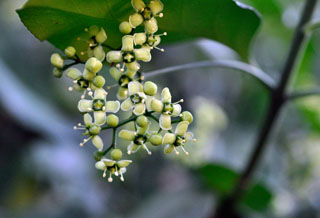WINTERCREEPER
|
 |
| File Size: 61 KB |
|
|
|
Euonymus fortunei (Turcz. ) Hand.-Mazz.
|
| Riley County, Kansas |
| Height: Vines, to 65 feet long |
| Family: Celastraceae Staff Tree Family |
| Flowering Period: May, June, July |
|
| Also Called: | | Chinese spindle-tree. | | Trunks: | | Stems prostrate or climbing by adventitious roots; bark reddish brown to gray, smooth or slightly flaky; wood white or yellowish white, hard. | | Twigs: | | Green to greenish brown, flexible, terete to more or less 2-3-angled, not corky winged, glabrous, glaucous; leaf scars crescent-shaped to half-round; buds pink to greenish purple, elongate-ovoid, .2 to .4 inch, apex acute, scales glabrous, more or less glaucous. | | Leaves: | | Persistent, opposite, simple; stipules caducous, lanceolate, to .04 inch; petiole .2 to .4 inch; blade lanceolate to ovate, elliptic, or obovate-elliptic, .8 to 3.6 inches long, .2 to 2 inches wide, base cuneate to obtuse or rounded, margins crenate-serrate, apex obtuse to acute or acuminate, lower surface light green, glabrous, upper surface dark green, glabrous. | | Flowers: | | Inflorescences axillary on new growth, cymes, 5-25-flowered; peduncles .6 to 2 inches, glabrous, thicker distally; pedicels .2 to .4 inch, glabrous. Flowers bisexual, radially symmetric; sepals 4, distinct, green, ovate, .04 to .06 inch; petals 4, distinct, white to greenish yellow, oblong to broadly obovate, .12 to .16 inch long, .08 to .12 inch wide; disk 4-lobed, green; stamens 4, to .12 inch; pistil 1, ovary superior, 4-locular, embedded in disk; style .06 to .08 inch; stigma slender, not distinctly lobed. | | Fruit: | | August-November; capsules, tan to pinkish green or orange, obovoid to nearly globose, shallowly 2-4-lobed, .2 to .3 inch long, .2 to .3 inch wide, smooth; seeds 2 per locule, yellowish brown, ellipsoid, .16 to .28 inch long, .14 to .2 inch wide, more or less rugose; aril orange, completely surrounding seed. | | Habitat: | | Floodplain forests, stream banks, mesic upland forests, disturbed sites. | | Distribution: | | Scattered in east 1/2 of Kansas | | Origin: | | Naturalized | | Comments: | | Euonymus fortunei is native to Asia and was introduced as an ornamental. Many cultivars have been developed. Wintercreeper was first reported in Kansas in 1995; it is probably much more common in Kansas than the specimen records suggest. Flowers and fruits are produced only on climbing stems. Vegetative stems can form dense mats on forest floors, sometimes crowding out other species. |
|
| Wintercreeper inflorescence |  | | 105 KB | | Riley County, Kansas |
| | Wintercreeper flowers |  | | 47 KB | | Riley County, Kansas |
| | Wintercreeper bark |  | | 108 KB | | Riley County, Kansas |
| | Wintercreeper leaves |  | | 79 KB | | Riley County, Kansas |
| | Wintercreeper buds |  | | 27 KB | | Wildcat Glades, Newton County, Missouri |
| | Wintercreeper fruit |  | | 64 KB | | Riley County, Kansas |
| | Wintercreeper fruit |  | | 122 KB | | Riley County, Kansas |
| | Wintercreeper fruit |  | | 133 KB | | Riley County, Kansas |
| | |
|
|
|